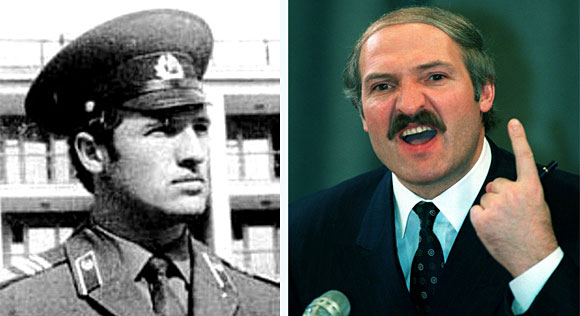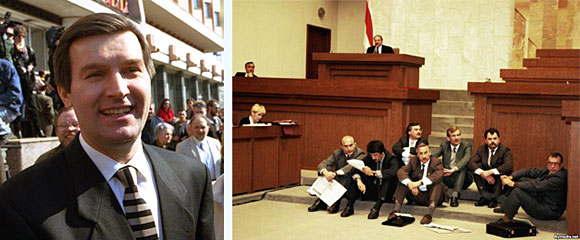“Batka” or Father
The speed of Lukashenko’s rise staggers the imagination. He was born on August 30th, 1954 in the village of Kopys in the Vitebsk region of Belarus. He graduated from the Mogilev Pedagogical Institute as a teacher of history and social science and later, studied at the Belarusian Agricultural Academy. Advancing rapidly up the party hierarchy, Lukashenko, in 1987, was appointed to head a state farm in the Mogilev region. In 1990, he was elected Deputy to the Supreme Soviet of Belarus and quickly attracted public and media attention as the result of his speeches criticizing the Supreme Soviet’s Chairman, Stanislav Shushkevich.

From 1975 to 1977 Lukashenko was doing his military service in the Soviet Border Troops as an instructor of political department. According to some sources, in 1991 Lukashenko was the only Deputy of the Supreme Soviet who did not vote for the dissolution of the USSR.
On May 25th, 1991, Narodnaya Volya published Lukashenko's article, entitled “Dictatorship: Belarusian Version” in which the future Belarusian president appears as an ardent advocate of democratic values. Only five years later, Lukashenko completely abandoned all the ideas propounded in this article.
In 1993, Lukashenko headed the Anti-Corruption Commission of the Supreme Soviet. The strong anti-corruption report he made to parliament caused a great stir and resulted in the resignation of Stanislav Shushkevich. It was Lukashenko’s moment of glory and his popularity thereafter grew rapidly.
In June 1994, Lukashenko decided to run in Belarus’ first (and, as it turned out, last) free presidential elections. There were five other candidates competing for the office, representing a wide political spectrum—from Communists to nationalists. However, the political parties that put forward their candidates were weak, and the candidates themselves lacked popular support. In the first round of voting, none of them managed to gain the necessary percentage of votes to be elected. There was a run-off between the two candidates with the highest number of votes: the populist, Alexander Lukashenko, who received 44.82% of votes, and Belarusian Prime Minister Vyacheslav Kebich, who had 17.33%. In the run-off, Lukashenko defeated his opponent with an overwhelming 80.1% of votes.
As many analysts have observed, Lukashenko’s fantastic success was determined by two factors. First, his campaign exploited the discontent felt by the majority of Belarusians for whom the the economic crisis, changes in the political system, and the high level of nationalism was unacceptable. Second, Lukashenko was able to project an image of himself as “a man of the people” that he was able to set against the elitism and “detachment from the people,” of the other candidates who represented the political establishment.
Paradoxically, in terms of ideology, Lukashenko was hardly any different from his opponent in the run-off. Neither relied on any party, nor had an intelligible political program, and both, in the course of their political careers, changed their views to suit the political winds prevalent at the time. A clear illustration of the last point is Lukashenko’s attempt to appoint Kebich as Speaker of the Supreme Soviet, even though, earlier, he had promised to jail Kebich. He also surrounded himself with people who came from Kebich’s inner circle.
One of the factors that determined Lukashenko’s fantastic success was his ability to project an image of himself as “a man of the people.” He was able to set this image against the elitism of the other candidates who represented the political establishment.
Lukashenko's program appealed to the paternalistic mood of the Belarusian public and included elements of left populism, traditional Slavophilism, and nostalgia for the Soviet era “Golden Age.” In essence, his was a program of authoritarian mobilization, and it was acceptable to the majority of Belarus’ citizens. “Freedom was bargained for stability, leveling social policies and a familiar system of political and ideological principles,” writes Shimov.
After life in Belarus had returned to normal from the turbulence of the early 1990’s, the authoritarian model became irrelevant. However, rejection of the model in Belarus did not take place. For Lukashenko and the new political elite, the only way to guarantee their own security was to preserve their power. The point of no return was reached in 1996 during the referendum on amending the Constitution of Belarus. Many analysts and international observers see the events surrounding this vote as a state coup.
1996
From his first days in power, Lukashenko started to change the government system to suit his own needs. In 1995, this brought him into conflict with the Supreme Soviet, and thus began a long period of political crisis. The conflict became acute in August 1996, when Lukashenko suggested holding a referendum on constitutional amendments that would substantially broaden the power of the president and would turn Belarus from parliamentary-presidential republic into a presidential one. In response, the Supreme Soviet advanced a series of counter-proposals that were aimed at eliminating the presidential post and transforming the country into a parliamentary republic. November 24 was set as the date for the referendum.
In September 1996, Lukashenko's scheme for constitutional reform was categorically rejected by the parliament. Moreover, at the Supreme Soviet's request, the Constitutional Court initiated a criminal case against the Belarusian president for violation of the Constitution. Impeachment of the president was put on the parliamentary agenda.

In 1996, Viktor Gonchar (left) was unlawfully fired from his post as the Chairman the Belarusian Central Election Commission only 10 days prior to the referendum on amending the Constitution. By that time the political conflict between the Supreme Soviet and President Lukashenko had reached its peak (right).
Shortly before the referendum, a high-profile delegation came from Moscow to help resolve the political crisis in Belarus. The delegation included Russian Prime Minister Viktor Chernomyrdin, Federation Council Chairman Yegor Stroyev, and Duma Chairman Gennady Seleznev. Alexander Lukashenko and Semyon Sharetsky, Speaker of the Belarusian Supreme Soviet and leader of Agrarian Party, participated in the negotiations. After a day, a compromise was seemingly reached: Lukashenko agreed that the results of the referendum would be consultative only, and the Supreme Soviet agreed to withdraw its complaint to the Constitutional Court and terminate the case against Lukashenko for violation of the constitution.
However, on the next day, this compromise was rejected by the parliament at the initiative of the Civil Action fraction that saw it as “capitulation.” Reacting to the news, Lukashenko immediately announced that the results of the referendum would be legally binding.
From his first days in power, Lukashenko started to change the government system to suit his own needs.
According to the official numbers reported by the Belarusian Central Election Committee (CEC) 70.45% of the Belarusians voted for Lukashenko's project of constitutional reform. However, the electoral process was marred by so many violations that the referendum’s legitimacy was completely undermined. Below are examples of the violations:
• Ten days before the referendum Viktor Gonchar, head of the CEC, was unlawfully fired by the President’s decree (not by the decision of the Supreme Soviet, as required by the Constitution).
• When the early voting started, papers with texts of the suggested constitutional amendments were not available at the polling stations. In other words, the people did not know what they were voting for. Yet the authorities called for and, in many cases, forced people to go and vote early. As a result, up to 30% did vote early.
• Ballots were printed by the Presidential Property Management Department and were delivered to the polling stations bypassing the CEC and regional referendum commissions. There were no official records of the ballots.
• Ninety percent of the referendum coverage on radio and television was given to the president. In some cases, activists continued to campaign for the Lukashenko amendments right at the polling stations.
On the day following the referendum, Alexander Lukashenko reported that the voting went “flawlessly.” At the same time, eight judges of the Constitutional Court, including the chairman, resigned in protest against the way the referendum was conducted. Some members of the government, including Prime Minister Mikhail Chigir, Minister of Labor Alexander Sosnov, and Deputy Minister of Foreign Affairs Andrei Sannikov followed their example. Many international organizations, such as the OSCE, the European Council, and the EU, did not recognize the results of the referendum. But far more significant for Lukashenko and his further career, was the fact that the results were recognized as valid by Russia.

